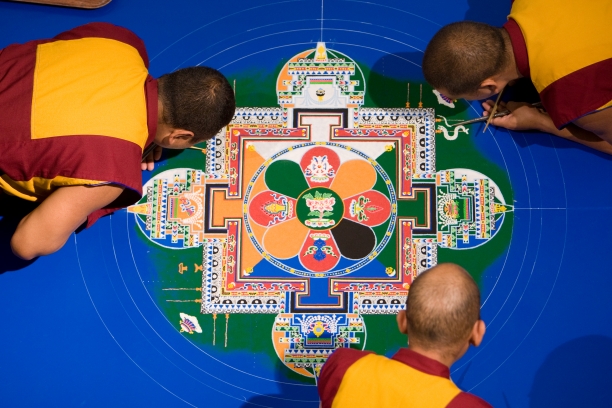Buddhist monks to create intricate sand mandala

Buddhist monks create a sand mandala
The monks of the Namgyal Monastery Institute of Buddhist Studies will create and deconstruct a sand mandala at Lehigh University from Oct. 22 to Friday, Oct. 26.
The monks, acting as cultural ambassadors from the exiled personal monastery of His Holiness the Dalai Lama in Dharamsala, India, will painstakingly create the complex design using grains of colored sand on a platform in the rotunda of Linderman Library.
Members of the Lehigh community and general public are welcome to observe the process from the hours of 9 a.m. to noon and 1:30 to 5 p.m. Monday through Thursday.
A public viewing will also be held from 9 to 10 a.m. on Friday, Oct. 26, and will be immediately followed by a dismantling ceremony that will take place between 10 and 10:30 a.m.
The creation of the sand mandala by the monks—who have become especially well known for the creation of sand mandala exhibitions in museums and galleries throughout the world—is part of a lead-up to the Dalai Lama’s historic visit to Lehigh in July 2008. At that time, he will present a series of teachings sponsored by the Tibetan Buddhist Learning Center in Washington, N.J., in collaboration with the university.
The spiritual leader of Tibet, who received the Nobel Peace Prize in 1989, will teach for six days at Stabler Arena on Tsong-kha-pa’s Great Treatise on the Stages of the Path to Enlightenment: The Lamrim Chenmo.
Lehigh has partnered with the city of Bethlehem to hold the dismantling ceremony at Sand Island, and extends their gratitude to local vendors Crystal Signatures and Moose and Bug florists for their support of this event.
A long and disciplined effort
Pronounced “mahn-DAH-la,” meaning “house” or “palace,” the mandala represents a Buddha's divine place of residence. To create one, millions of grains of sand are painstakingly laid into place on a flat platform over a period of time before ultimately being dismantled in order to release and disseminate blessings into the world, according to the Web site of the Namgyal Monastery Institute of Buddhist Studies.
The construction of a mandala is a long and disciplined effort, the Web site explains, but metaphorically also symbolizes the impermanence of life. When the monks have completed the sand mandala, there is a deconstruction ceremony where the sand mandala is dismantled and the sand is cast into a body of water to emphasize and highlight the impermanence of all things and the importance of nonattachment.
Immensely complex symbolic structures, mandalas are characterized by many layers of meaning and beauty. Although aesthetically pleasing, they were intended for religious use. It is only in recent years that His Holiness the Dalai Lama has permitted mandalas to be made in public as a means of teaching about Tibetan culture.
The official history of the Namgyal Monastery notes that the monastery was founded in 16th-century Tibet by the second Dalai Lama, Gendun Gyatso. Since its founding, the Namgyal monks have assisted the Dalai Lamas in public religious affairs and have performed ritual prayer ceremonies for the welfare of Tibet. The monastery was also established as an esteemed center of learning, contemplation and meditation on the vast and profound Buddhist treatises.
There are currently four Namgyal Monasteries in existence today—three in India and the Namgyal Monastery Institute of Buddhist Studies in Ithaca, N.Y., which is the North American Seat of the Personal Monastery of His Holiness the Dalai Lama.
For more information on the historic visit, please visit the Dalai Lama at Lehigh Web site.
For more information on the Namgyal Monastery Institute of Buddhist Studies, visit the institute’s Web site.
--Linda Harbrecht
Posted on:

